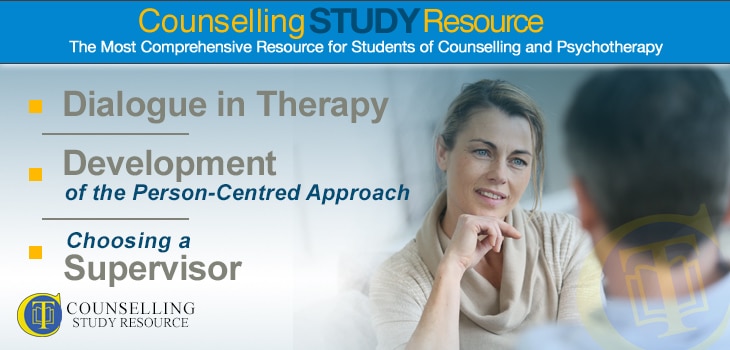045 – Dialogue in Therapy – Development of the Person-Centred Approach – Choosing a Supervisor
In episode 45 of the Counselling Tutor Podcast, Rory Lees-Oakes and Ken Kelly talk about how to avoid asking, ‘How does that make you feel?’ ‘Theory with Rory’ looks at three key phases in the development of person-centred counselling. Last, the presenters offer tips on finding a suitable counselling supervisor.
Dialogue in Therapy (starts at 3.50 mins)
‘How does that make you feel?’ has become a rather laughable question, often used to parody counsellors on TV etc. But since counselling is all about feelings, how do we avoid asking this stereotypical question?
Ken points out that in fact ‘How does that make you feel?’ distances us from the client, as it suggests we have no idea what emotions they might be experiencing. Listening to a client’s story, noticing their body language, using our intuition, and listening out for words that indicate underlying emotion can always enable us to have a go at saying what we think they might be feeling: they can then confirm this, or correct us.
Rory talks about the importance of getting the language right when we do this – using words that fit with the client’s own understanding and use of language. It’s important not to assume that everyone has the same breadth of vocabulary for emotions, and it may be hard for clients to find the right word to explain what they are feeling. As therapists, we can work on expanding our ‘feelings vocabulary’ by writing a regular journal in which we can work on finding just the right words to describe our experiences.
Development of the Person-Centred Approach (starts at 15.03 mins)
Since its beginning in the 1950s, person-centred counselling has developed considerably, and continues to do so today. There are many different branches of person-centred therapy, as described in The Tribes of the Person-Centred Nation (edited by Pete Sanders, PCCS books, 2012). However, all would agree on the key tenets of Carl Rogers’ approach:
- the six necessary and sufficient conditions for therapeutic personality change
- the seven stages of process (though some therapists believe these to be less linear than Rogers suggested)
- phenomenology
- the 19 propositions
Because Rogers did not prescribe any particular template, there are as many different styles of person-centred therapy as there are therapists themselves: we are all different, and it is important in this modality to be ourselves.
Rory describes three key stages in the development of person-centred counselling over its first 30–40 years:
- The first phase (1940–1950), when Carl Rogers first introduced his ideas, could be termed ‘non-directive psychotherapy’. This represented a big challenge to the two types of therapy that prevailed at that time, psychoanalysis and behaviourism, which were used to telling clients how they were and what they should do. In contrast, non-directive psychotherapists listened to and sought to understand the client’s experience.
- In the second phase (1950–1957), ‘reflective psychotherapy’ (so-called as the therapist reflected the client’s feelings – the focus was on avoiding threat in the therapeutic relationship, by being congruent and real. This represented another step away from psychoanalysis and behaviourism.
- The third phase (1957–1970) is known as ‘experiential psychotherapy’; it involved therapists becoming even more congruent in terms of expressing to clients how they were experiencing them. This can be a really useful form of feedback for clients on their process. This evolved into focusing, as developed by Eugene Gendlin, one of Rogers’ students.
Rory has prepared a handout on this topic, which you can download free of charge.
Free Handout Download
Three Periods in Person-Centred Therapy
Choosing a Supervisor (starts at 24.45 mins)
Ken and Rory provide tips on what to think about when choosing a counselling supervisor:
- Check that the supervisor has sound knowledge and experience of your modality.
- Choose carefully, as it’s not easy to change part-way through training (as you may need them to write both a 50-hour and 100-hour report).
- Ask which professional body’s standards they work to: it may be useful to choose a supervisor who belongs to the same one as you.
- If you will be working with a specific client group (e.g. bereavement), try to find a counsellor with an interest and experience in this field.
- Ask how the supervisor will support you if you are ever feeling ‘less than’ – it is normal to have crises of confidence, and it’s important to have a supervisor who can support you at such times.
- Visit three to four supervisors before deciding which one to go with.
- When meeting possible supervisors, don’t get put off by transference. If you don’t like someone, try to work out why before making a final decision.
- Make sure you can feel safe, in a threat-free environment. It is the stuff you are most ashamed of that is the most important to bring to supervision!
- If your placement agency wants you to use a supervisor there, ask yourself whether you feel happy with this. Might you want an external supervisor too? If so, how would it work in practice using both?
Robert Shohet is a key figure in the development of supervision theory, having developed – with Peter Hawkins – the seven-eyed model.
